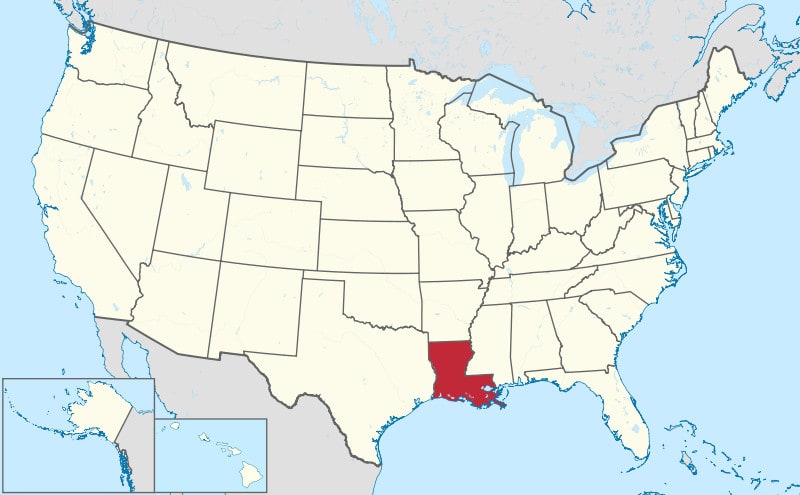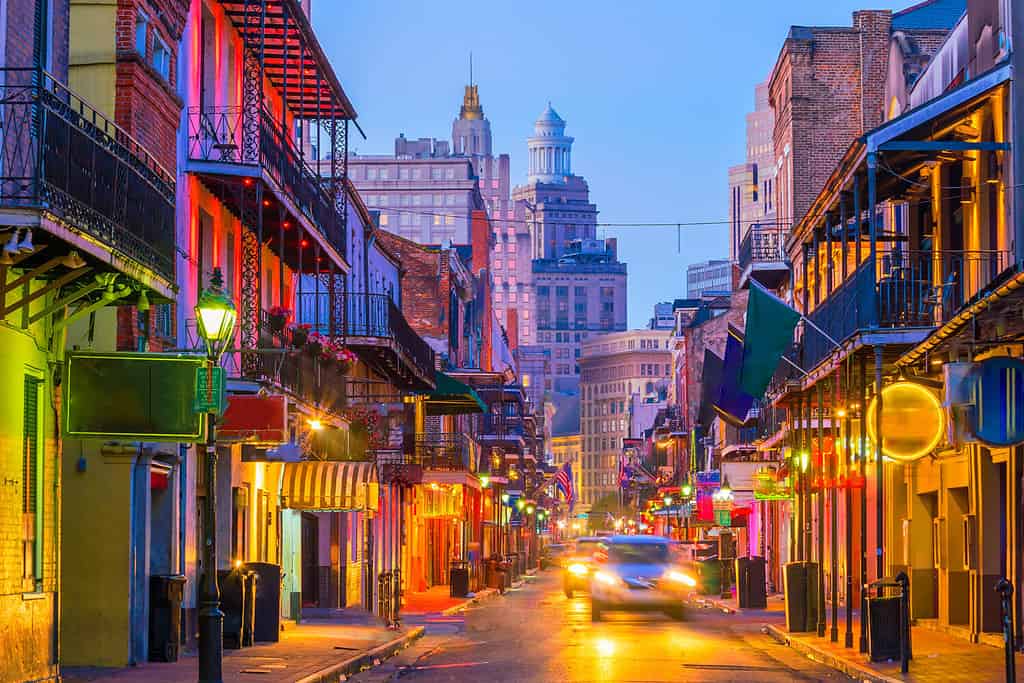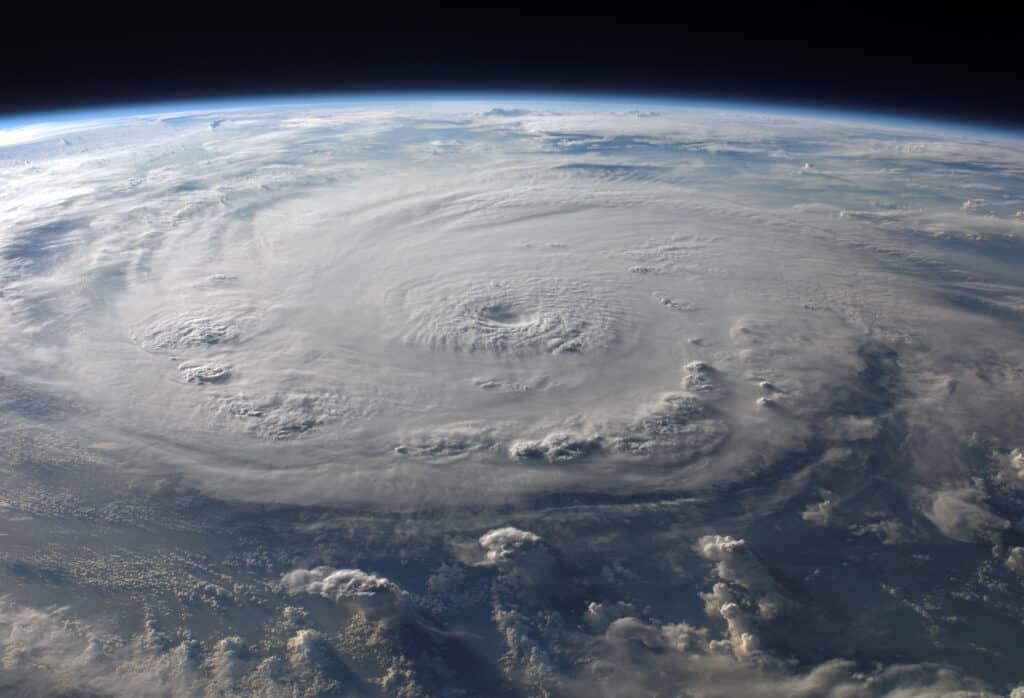Louisiana is well-known for its food, music, and Cajun culture, but what about its elevation? Here’s a look at the lowest point in the Pelican State.
Lousiana
Louisiana is home to 4,590,241 residents (2022 U.S. Census estimate). It is located in the Deep South of the United States. Its southern border sits on the Gulf of Mexico. The state is bordered by Texas to the west, Arkansas to the north, and Mississippi to the east.
Louisiana is tied with Florida for the second-lowest mean elevation of all U.S. states. Both have a mean elevation of 100 feet above sea level. The only state with a lower mean elevation is Delaware, at 60 feet above sea level.
Clearly, Louisiana has an extraordinarily low elevation, but what is the lowest point in the entire state? The lowest point in Lousiana also happens to be the state’s largest city.

Louisiana sits on the Gulf of Mexico in the Deep South of the United States.
©TUBS / CC BY-SA 3.0 – License
New Orleans
The city of New Orleans is the lowest point in Louisiana. The elevation of the city varies from twenty feet above sea level to seven feet below sea level. That low point, which is found in extreme eastern New Orleans, is the lowest point in Louisiana.
New Orleans was originally founded on the higher ground of natural levees created by the Mississippi River. However, the Flood Control Act of 1965 would forever change the footprint of the city. The act authorized the United States Army Corps of Engineers (USACE) to design and build flood control projects, including projects around Lake Pontchartrain and in the city of New Orleans itself. These projects were intended to create protection systems in the event of tropical storms and hurricanes, but they also increased the development potential of New Orleans.
USACE built levees and floodwalls around New Orleans, including marsh and swamp lands that had yet to be developed. Once the pumps removed water from these wetlands, it allowed for development in previously unbuildable areas.
Today, more than half of New Orleans proper is at or below sea level. It is the 18th lowest point in the United States and the lowest point outside of California. The pump system is critical to keep New Orleans from flooding. The city is so low that it has no natural watershed, so rainwater must be pumped out of the city. The New Orleans pumping system can pump water out of the city at rates over 45,000 cubic feet per second.

New Orleans is Louisiana’s largest city, as well as its lowest point in elevation.
©f11photo/Shutterstock.com
Hurricane Katrina
The low elevation and the inadequate levee systems of New Orleans proved to be a catastrophic combination in the summer of 2005. New Orleans received a direct hit from a high-end Category 3 hurricane (it had reached Category 5 status before weakening slightly ahead of its landfall). Hurricane Katrina delivered upwards of ten inches of rain in New Orleans. The rain, combined with a storm surge of 10 to 20 feet above normal tide levels, devastated New Orleans.
The manmade walls and levee systems were overwhelmed by the deluge. There were over 50 failures in the systems around Greater New Orleans, including six major breaches in the city itself. These failures allowed water from the Gulf of Mexico and Lake Pontchartrain to pour into the city. The storm made landfall in southeast Louisiana and Mississippi on August 29, 2005. By August 31, 80% of New Orleans was underwater.
Hurricane Katrina claimed over 1,800 lives, making it one of the deadliest storms in U.S. history. It was also the costliest storm in American history at $193.8 billion.
Numerous studies have concluded that the disaster was largely, if not entirely due to the inadequate design of the flood protection system built by USACE. Larry Roth, the Deputy Executive Director of the American Society of Civil Engineers, called the levee failures “the worst engineering catastrophe in U.S. history.”

Hurricane Katrina devastated New Orleans in August 2005.
©LiL SUS/Shutterstock.com
Lessons Learned
After the Katrina catastrophe, USACE rebuilt the levees around the city. Newly designed systems were installed to keep the waters of Lake Pontchartrain and the Gulf of Mexico at bay. The systems were tested when Hurricane Ida hit New Orleans sixteen years to the day after Katrina. The systems performed as expected, though the need for further upgrades was revealed due to the storm. USACE requested further funding from Congress to make the needed improvements.

Over 80% of New Orleans was flooded by Hurricane Katrina.
©Tad Denson/Shutterstock.com
New Orleans Today
No one will ever forget the tragedy of Katrina (nor should they), but New Orleans has rebounded from the devastation. Today, it is once again a vibrant and unique American city.
New Orleans is famous for its Cajun and Creole cuisine. If you’re visiting the Big Easy, be sure to come hungry! Guests also admire the beauty of the historic French and Spanish Creole architecture. Then there’s the music. Brass bands and jazz music are ubiquitous in New Orleans. The biggest event of the year, not just in New Orleans but in Louisiana as a whole, is the annual Mardi Gras celebration. Millions of people take part in the revelry.
The Travel recently reported that New Orleans is the eleventh most-visited city in the United States. For those who love to travel, this city is one that is not to be missed!

Mardi Gras is the biggest annual event in Louisiana.
©Drazen Zigic/Shutterstock.com
The photo featured at the top of this post is © iStock.com/Oleksii Liskonih
Thank you for reading! Have some feedback for us? Contact the AZ Animals editorial team.







